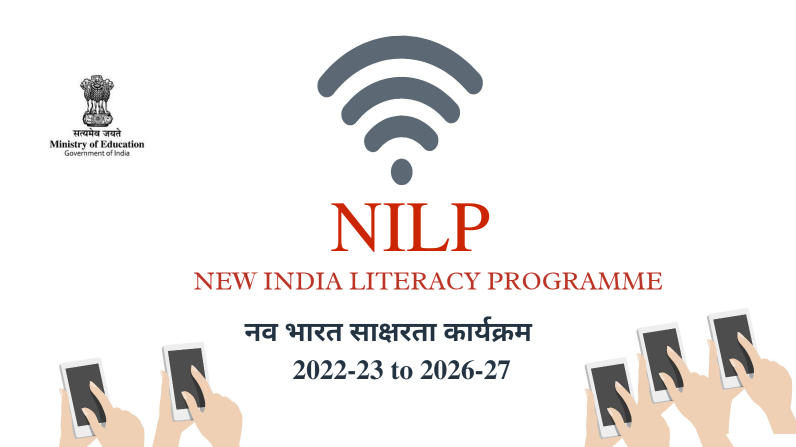New India Literacy Programme (NILP) (GS Paper 2, Education)

Why in News?
- The Union Ministry of Education (MoE) has recently clarified its definition of "literacy" and the criteria for achieving "full literacy" in a directive sent to all states.
- This move is a part of the New India Literacy Programme (NILP) initiative aimed at advancing adult literacy across the country.
What is the New India Literacy Programme (NILP)?
Overview:
- Full Name: ULLAS - Nav Bharat Saksharta Karyakram / New India Literacy Programme (NILP).
- Launch & Duration: Launched to be implemented from FY 2022-23 to FY 2026-27.
- Financial Outlay: ₹1,037.90 crore, which includes ₹700 crore from the Central Government and ₹337.90 crore from the State Governments.
Objective:
- The NILP is designed to address adult illiteracy by providing educational opportunities to individuals aged 15 and above who have missed out on formal schooling.
- The goal is to help these adults become functional literates, thereby empowering them to contribute effectively to societal and economic development.
Components:
- Foundational Literacy and Numeracy (FLN): Focuses on basic reading, writing, and arithmetic skills.
- Critical Life Skills: Encompasses essential skills needed for daily life, including digital and financial literacy.
- Vocational Skills Development: Aims to enhance employability by providing skills relevant to various trades and professions.
- Basic Education: Offers fundamental educational content and knowledge.
- Continuing Education: Supports lifelong learning and skill enhancement beyond initial education.
Implementation Strategy:
- Beneficiary Identification: Utilizes mobile apps for door-to-door surveys and direct registrations to identify non-literate individuals.
- Volunteerism: Encourages the participation of volunteers who can register through mobile apps to assist in teaching and learning.
- Technology Integration: Primarily delivered through online platforms, with resources available on DIKSHA (Digital Infrastructure for Knowledge Sharing) by NCERT. The program also employs traditional media like TV, Radio, and Samajik Chetna Kendra for outreach.
Who is Considered Literate under the NILP?
Definition of Literacy:
- Literacy is defined as the ability to read, write, and perform basic arithmetic with comprehension.
- It also includes critical life skills such as digital literacy (using technology effectively) and financial literacy (managing personal finances).
Definition of Full Literacy:
- A State or Union Territory (UT) is considered fully literate if it achieves a literacy rate of 95%.
Certification Process:
- Foundational Literacy and Numeracy Assessment Test (FLNAT): Individuals are declared literate upon passing this test, which evaluates their basic literacy and numeracy skills.
- 2023 Data: Out of 39,94,563 adult learners who appeared for the FLNAT, 36,17,303 were certified as literate.
Significant Literacy Challenge Faced by India
High Number of Non-Literate Individuals:
- Census 2011 Statistics: Approximately 25.76 crore people aged 15 and above are non-literate. The disparity is particularly pronounced between genders, with 9.08 crore males and 16.68 crore females being non-literate.
Challenges Faced by Non-Literate Individuals:
- Financial Transactions: Difficulty in managing personal finances and understanding financial products.
- Job Applications: Challenges in applying for jobs and understanding employment-related documents.
- Media and Technology Comprehension: Limited ability to interpret media content and utilize technology effectively.
- Understanding of Rights: Lack of awareness about personal rights and legal protections.
- Economic Participation: Difficulty in participating in higher productivity sectors and contributing to economic growth.
Ineffectiveness of Past Initiatives:
- Saakshar Bharat Program: Despite certifying 7.64 crore people as literate from 2009–10 to 2017–18, around 18.12 crore adults remain illiterate, highlighting the need for more effective measures.
FLNAT Exam Performance:
- Pass Percentage: The pass percentage for FLNAT was between 89.64% and 91.27% in 2023. In 2024, this figure dropped to 85.27%, indicating potential challenges in maintaining high literacy standards.
Budget Allocation Issues:
- 2023-24 Allocation: Initially set at ₹157 crore, but later revised down to ₹100 crore, which may affect the program’s implementation and outreach.
Conclusion
- The New India Literacy Programme (NILP) represents a comprehensive effort by the Indian government to tackle adult illiteracy and integrate non-literate individuals into the socio-economic mainstream.
- By focusing on foundational literacy, critical life skills, and vocational training, the NILP aims to provide meaningful educational opportunities to adults who missed out on formal schooling.
- However, significant challenges remain, including a large number of non-literate individuals, especially women, and the effectiveness of past literacy initiatives.
- The drop in FLNAT pass rates and budgetary constraints further complicate efforts to achieve high literacy rates.
- Continued focus on these areas, along with innovative strategies and enhanced funding, will be crucial for the success of the NILP and for making substantial progress in adult literacy in India.


